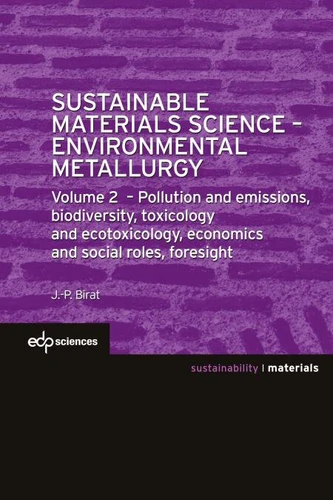Sustainable Materials Science - Environmental Metallurgy. Volume 2, Pollution and emissions, biodiversity, toxicology and ecotoxicology, economics and social roles, foresight
Par :Formats :
Disponible dans votre compte client Decitre ou Furet du Nord dès validation de votre commande. Le format PDF est :
- Compatible avec une lecture sur My Vivlio (smartphone, tablette, ordinateur)
- Compatible avec une lecture sur liseuses Vivlio
- Pour les liseuses autres que Vivlio, vous devez utiliser le logiciel Adobe Digital Edition. Non compatible avec la lecture sur les liseuses Kindle, Remarkable et Sony
 , qui est-ce ?
, qui est-ce ?Notre partenaire de plateforme de lecture numérique où vous retrouverez l'ensemble de vos ebooks gratuitement
Pour en savoir plus sur nos ebooks, consultez notre aide en ligne ici
- Nombre de pages680
- FormatPDF
- ISBN978-2-7598-2444-1
- EAN9782759824441
- Date de parution22/02/2021
- Protection num.Digital Watermarking
- Taille12 Mo
- Infos supplémentairespdf
- ÉditeurEDP Sciences
Résumé
The present book is the continuation of a first volume, which dwelt on fairly classical materials science and environmental issues. This second volume of « Sustainable Materials Science » explores more broadly the connection of materials with the biosphere, the anthroposphere and society. There is a shift, therefore, from a STEM approach (Science, Technology, Engineering and Mathematics) to an SSH one (Social Sciences and Humanities).
This book is meant for students, researchers, engineers, social scientists and concerned citizens interested in how materials, nature and people interact.
This volume concentrates on emissions to air, water and soil, on the connection with health and toxicology, climate change and the c collapse of biodiversity. It shows how materials exhibit a social value, in addition to their engineering properties and economic valuation. Materials also provide ecosystems services in the realm of industrial ecology. They are definitely social constructs. They exhibit agency.
Their role, in their value chains, can be described in terms of Actors Network Theory (ANT). This book is unique in its approach of overarching so many fields of knowledge. There are excellent treatises on materials science and on industrial ecology. However, the connection of materials with the social dimension of sustainability is rarely discussed elsewhere and the pluridisciplinary cocktail of approaches used here is truly new.
The book positions itself in a worldview of four intersecting dimensions: materials and energy, space and time.
This volume concentrates on emissions to air, water and soil, on the connection with health and toxicology, climate change and the c collapse of biodiversity. It shows how materials exhibit a social value, in addition to their engineering properties and economic valuation. Materials also provide ecosystems services in the realm of industrial ecology. They are definitely social constructs. They exhibit agency.
Their role, in their value chains, can be described in terms of Actors Network Theory (ANT). This book is unique in its approach of overarching so many fields of knowledge. There are excellent treatises on materials science and on industrial ecology. However, the connection of materials with the social dimension of sustainability is rarely discussed elsewhere and the pluridisciplinary cocktail of approaches used here is truly new.
The book positions itself in a worldview of four intersecting dimensions: materials and energy, space and time.
The present book is the continuation of a first volume, which dwelt on fairly classical materials science and environmental issues. This second volume of « Sustainable Materials Science » explores more broadly the connection of materials with the biosphere, the anthroposphere and society. There is a shift, therefore, from a STEM approach (Science, Technology, Engineering and Mathematics) to an SSH one (Social Sciences and Humanities).
This book is meant for students, researchers, engineers, social scientists and concerned citizens interested in how materials, nature and people interact.
This volume concentrates on emissions to air, water and soil, on the connection with health and toxicology, climate change and the c collapse of biodiversity. It shows how materials exhibit a social value, in addition to their engineering properties and economic valuation. Materials also provide ecosystems services in the realm of industrial ecology. They are definitely social constructs. They exhibit agency.
Their role, in their value chains, can be described in terms of Actors Network Theory (ANT). This book is unique in its approach of overarching so many fields of knowledge. There are excellent treatises on materials science and on industrial ecology. However, the connection of materials with the social dimension of sustainability is rarely discussed elsewhere and the pluridisciplinary cocktail of approaches used here is truly new.
The book positions itself in a worldview of four intersecting dimensions: materials and energy, space and time.
This volume concentrates on emissions to air, water and soil, on the connection with health and toxicology, climate change and the c collapse of biodiversity. It shows how materials exhibit a social value, in addition to their engineering properties and economic valuation. Materials also provide ecosystems services in the realm of industrial ecology. They are definitely social constructs. They exhibit agency.
Their role, in their value chains, can be described in terms of Actors Network Theory (ANT). This book is unique in its approach of overarching so many fields of knowledge. There are excellent treatises on materials science and on industrial ecology. However, the connection of materials with the social dimension of sustainability is rarely discussed elsewhere and the pluridisciplinary cocktail of approaches used here is truly new.
The book positions itself in a worldview of four intersecting dimensions: materials and energy, space and time.





